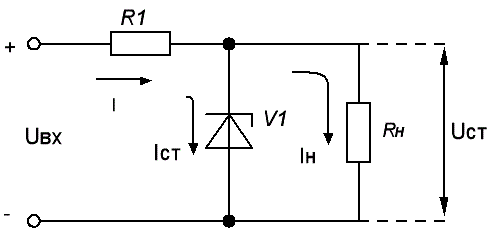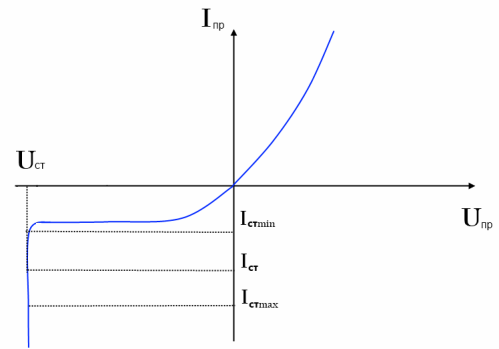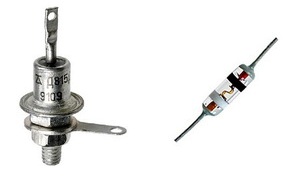How a zener diode works
Zener diode or zener diode (semiconductor zener diode) is a special diode that operates in a stable breakdown mode under reverse bias conditions of the pn junction. Until this breakdown occurs, only a very small current flows through the zener diode, the leakage current, due to the high resistance of the closed zener diode.
But when a fault occurs, the current instantly increases because the differential resistance of the zener is at this point from fractions to hundreds of ohms. In this way, the voltage across the zener diode is maintained very precisely over a relatively wide range of reverse currents.

The Zener diode is called a Zener diode (from the English Zener diode) in honor of the scientist who first discovered the phenomenon of tunnel breakdown, the American physicist Clarence Melvin Zener (1905 — 1993).
The electrical breakdown of the pn junction, discovered by Zener, related to the tunneling effect, the phenomenon of electron leakage through a thin potential barrier, is now called the zener effect, which today serves in semiconductor Zener diodes.
The physical picture of the effect is as follows.In the reverse bias of the p-n junction, the energy bands overlap and electrons can move from the valence band of the p-region to the conduction band of the n-region, due to electric field, this increases the number of free charge carriers, and the reverse current increases sharply.

Thus, the main purpose of the zener diode is to stabilize the voltage. The industry produces semiconductor zener diodes with stabilization voltages from 1.8 V to 400 V, high, medium and low power, which differ in the maximum allowable reverse current.
Simple voltage stabilizers are made on this basis. In the diagrams, zener diodes are indicated by a symbol similar to the diode symbol, with the only difference that the cathode of zener diodes is depicted in the form of the letter «G».
Zener diodes with a latent integrated structure, with a stabilization voltage of about 7 V, are the most accurate and stable solid-state voltage reference sources: their best examples are characteristically close to the normal Weston galvanic cell (mercury cadmium reference galvanic cell) .
High-voltage avalanche diodes ("TVS-diodes" and "suppressors"), which are widely used in surge protection circuits of all kinds of equipment, belong to a special type of zener diodes.

As you can see, the zener diode, unlike the conventional diode, works on the reverse branch of the I — V characteristic. In an ordinary diode, if a reverse voltage is applied to it, failure can occur in one of three ways (or all at once): tunnel breakdown, avalanche breakdown, and breakdown due to thermal heating from leakage currents.
Thermal breakdown of silicon zener diodes is not important because they are designed so that either tunnel breakdown, avalanche breakdown, or both types of breakdown occur simultaneously long before the thermal breakdown trend. Series zener diodes are currently made mostly of silicon.
A breakdown at a voltage below 5 V is a manifestation of the Zener effect, a breakdown above 5 V is a manifestation of an avalanche breakdown. An intermediate breakdown voltage of about 5 V usually results from a combination of these two effects. The strength of the electric field at the moment of breakdown of the zener diode is about 30 MV / m.
Zener diode breakdown occurs in moderately doped p-type semiconductors and heavily doped n-type semiconductors. As the junction temperature increases, the zener diode stripping decreases and the avalanche breakdown contribution increases.

Zener diodes have the following typical characteristics. Vz — stabilization voltage. The documentation specifies two values for this parameter: the maximum and minimum stabilization voltage. Iz is the minimum stabilization current. Zz is the resistance of the zener diode. Izk and Zzk — current and dynamic resistance at direct current. Ir and Vr are the maximum leakage current and voltage at a given temperature. Tc is the temperature coefficient. Izrm — maximum stabilization current of the zener diode.
Zener diodes are widely used as independent stabilizing elements, as well as as sources of reference voltages (reference voltages) in transistor stabilizers.
To obtain small reference voltages, zener diodes are also switched on in the forward direction, like ordinary diodes, then the stabilization voltage of one zener diode will be 0.7 — 0.8 volts.
The maximum power dissipated by the body of a zener diode is typically in the range of 0.125 to 1 watt. This, as a rule, is sufficient for the normal operation of protective circuits against impulse noise and for the construction of low-power stabilizers.
